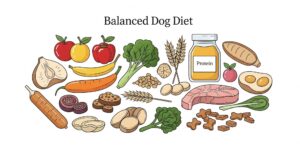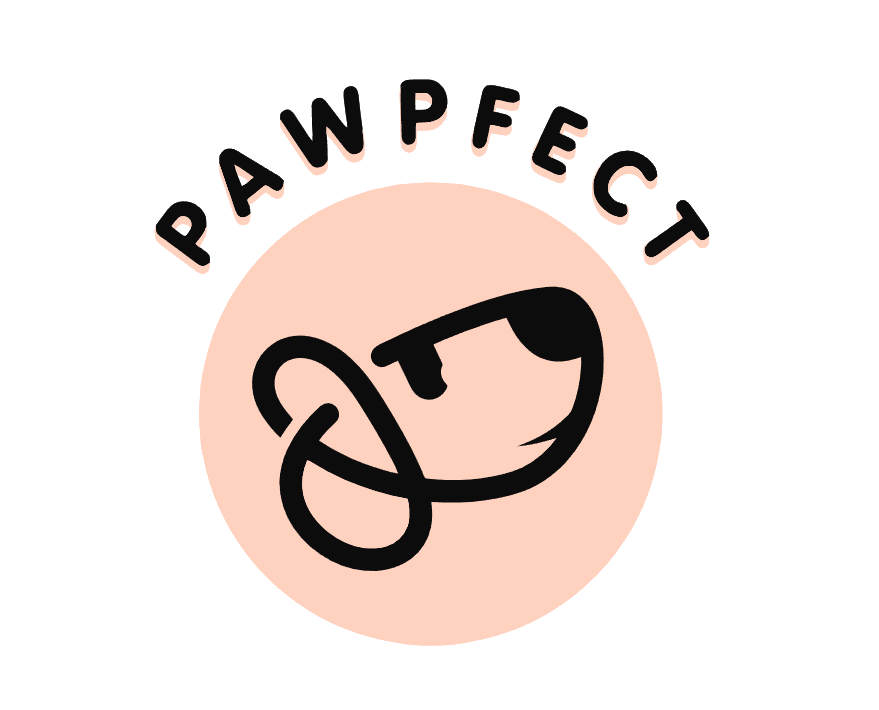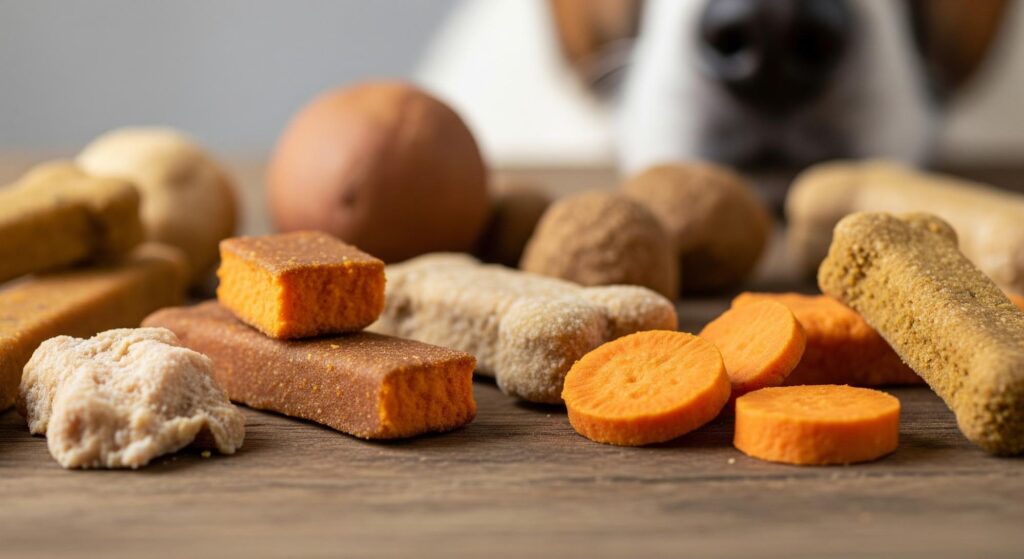You love your dog unapologetically, honestly, and with a soft spot for those pleading puppy eyes when the treat bag crinkles. We’ve all been there.
Eventually, those indulgent moments start to add up. Your dog’s belly becomes rounder and jigglier than usual. Outdoor strolls become slower, instead of energetic walks. And just like that, a treat that was wonderful initially becomes a threat to your dog’s health.
Dog weight management is not just about feeding less; it’s about feeding the right choices. Believe it or not, the answer might not to to eliminate all treats, but rather to choose them wisely.
Let’s take a closer look at how treats can help either derail or reinforce your dog’s journey to better health.
When Love Becomes a Health Risk
A few pounds may not seem like much until you consider that a dog’s five additional pounds is equivalent to a human’s 20. Obesity in dogs raises the risk of diseases such as arthritis, heart issues, diabetes, and even some types of cancers.
If you notice your dog panting a lot more than usual, napping frequently, and struggling to jump on the couch, it may be a sign that your dog is experiencing a gradual weight gain.
But don’t panic. You are not alone in this, and you are certainly not hopeless. Your vet can give you the best front-line advice. Many professionals in veterinary sales careers are working behind the scenes to provide connections between innovative pet nutrition brands and the vet clinics that recommend them.
This is the point where dog obesity prevention begins: with awareness, small changes in your pet’s activity routine, and a good look inside the treat jar.
How Overfeeding Can Trigger Health Problems in Dogs

Skipping the treats entirely from a dog’s diet is not a feasible solution. A little treat here and there does not hurt; however, overfeeding can cause a tragic impact on the health and wellness of dogs.
In many pet homes, portion control for dogs is frequently ignored. Most pet parents simply eyeball their dog’s treat amounts and follow the generic feeding recommendations from the food bags (which are usually generous).
The solution isn’t to simply starve your dog entirely. When managing your dog’s weight, aim to create a meal plan that aligns with their ideal weight, not their current weight. Once you have established control over your dog’s basic meals, you can evaluate the extra calories that your furry friend is ingesting between the meals. Yes, we’re talking about the treats. Occasional treats shouldn’t hurt, but an abundance of everything is bad and can have its consequences.
So, how do you shower your dog with love and appreciation without overfeeding them the wrong treats? Let’s break it down.
Good Treats vs. Bad Habits: What to Look For
Not all dog treats are the same. Some of them result in weight gain, while others help build muscle, gut health, and energy without adding extra fat.
Try to look for healthy dog treats made from:
- Single-ingredient proteins: chicken and salmon.
- Natural fibers such as pumpkin or sweet potato
- No artificial flavors or sugar
Want some quick wins? Replace your go-to commercial biscuits with crunchy veggies or freeze-dried meats. Visit Pawpfect to discover a comprehensive range of low-calorie dog snacks and more intelligent dog treat options; a pet parent-approved source for dog treats and interactive toys.
Now that we’ve covered dog treats, let’s zoom out and look at the bigger picture.
What a Balanced Dog Diet Means

Consider your dog’s diet as a puzzle. Each piece, meal, treat, hydration, and activity must create a complete picture of mental health.
A balanced dog diet should include the following:
- Lean proteins to help build muscle strength
- Fiber to promote digestion and fullness
- Healthy fats for skin, coat, and brain function
You can fill their bowls with veggies, low-calorie meals, or wet food blends without additional fats. Combine this with weight loss treats for dogs, and you’re not just feeding their body; instead, you’re fueling their health.
And when the diet aligns with movement, that’s where the real magic begins.
Dog Training Beyond Treats
Even though healthy treats play a key role in your dog’s weight management, they require a partner in crime: movement.
Whether it’s a brisk walk, a fun game of fetch, or food puzzles that make your pup work up for the treats, physical activity burns calories and keeps the metabolism healthy. It also helps to build lean muscles, aids digestion, and keeps the joints flexible.
Your dog can be motivated by treats; just use them wisely. Every sit, stray, and rollover is a good opportunity to reward and reinforce good behavior while keeping your dog active and healthy.
But remember, if your dog is still gaining weight despite the efforts, then something must be missing. It’s then time to step back and take a closer look.
When Treats Aren’t the Only Problem
Sometimes, weight gain is not caused by extra snacks and larger portions of meals. Hormonal imbalances, problems with the thyroid, or even low-grade arthritis, can cause your dog to be lethargic, and it can eventually lead to weight gain.
That’s where your dog veterinarian comes in. As professionals, they can rule out any underlying problems, recommend individualized diets, and suggest the right weight loss treatments for dogs based on your pups needs.
Even though you may never meet them, veterinary sales representatives are advocating on behalf of companies that rely on research to develop effective products and diets. They play a crucial role behind the scenes to ensure that clinics have access to the best weight loss products, including therapeutic diets, supplements, and dog treats.
Dog treats can vary in their quality and taste. Some of them are designed to achieve a health initiative. Long story short, many professionals contribute to the health and wellness of dogs.
Now let’s wrap things up.
Final Thoughts
Cutting down on the dog’s treats is not the solution. They do not only need fewer treats, but they also deserve better quality treats.
A dog’s weight management becomes easier with the right practice and appropriate meals. From mealtime to rewards, your choices shape your dog’s future health. The goal is not to restrict their diet, but to ensure that their feeding habits assist in their better health.
Take small steps. You can begin by choosing healthier snacks and treats for your dog. Reward them with purpose and intent.
Make each treat a part of your dog’s wellness journey. One bite at a time.
FAQs
Q: Is it a good idea to stop giving treats if my dog is overweight?
Not necessarily. Try to be smart and opt for low-calorie dog snacks or healthy dog treats with functional ingredients. It’s about rewarding your dogs smartly in smaller amounts. Even a single treat, if selected carefully, can help their health instead of hurting it.
Q: How many treats are safe per day?
Treats should not account for more than 10 percent of your dog’s daily intake. For effective portion control of dogs, always try to adjust meals if you give them treats often. Overtreating, even with healthier options, can slowly lead to weight gain in dogs.
Q: What makes a dog’s treat weight-friendly?
Find weight loss treats for dogs that contain lean proteins, fiber, and no additional sugars. Frozen-dried meats or snacks made from vegetables are a good option. These types of treats satisfy the cravings without adding extra calories.


